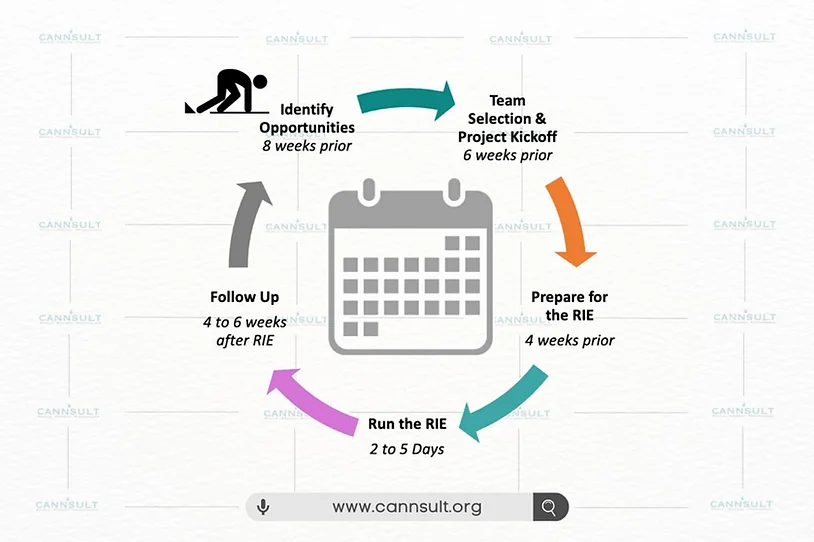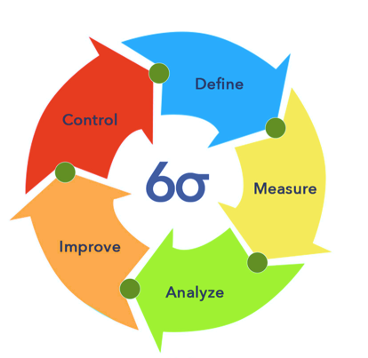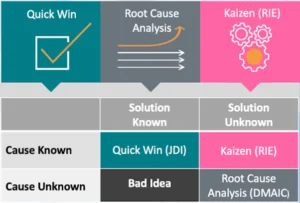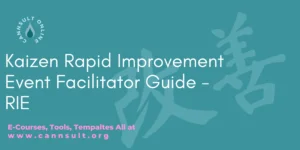The need for any improvement starts with a problem (or opportunity) in any given process. These many problems, big or small, cause waste, frustrations, clumsy processes, low productivity, and mistakes which all affect our employees and our customers. However, selecting what problems are worth going after, and then determining how we will improve can be more complicated than you might think!
What is Continuous Improvement with Kaizen?
There are many tools and methods that can drive Continuous Improvement. And Kaizen is one of those methods. The word Kaizen comes from two Japanese words; Kai (which means Change) and Zen (Which means good). Put together, the meaning of Kai Zen is to Change for the Better. In English, the word Kaizen is used as another term for Continuous Improvement. The term Kaizen – just like Continuous Improvement – is used in many ways. It can refer to a type of organization, a project, or even a personal endeavor.
While the word Kaizen refers to continual or daily improvement, when we place a specific focus on a particular issue, it is known as a Kaizen Event or a Kaizen Blitz. The word Blitz actually means a fast or violent attack and is used in sports or battle terminology. It’s a bit more colorful to say Kaizen Blitz than Kaizen Event, but it means the same thing.
How Kaizen Works

The Kaizen event is focused on a specific issue that can be resolved in a short amount of time. It involves a small team who devotes 100% of their time over a few days to analyzing and improving a narrowly defined targeted problem or opportunity.
Kaizen Events started as a team effort where a group of people who work together in the same area would identify an opportunity to improve…to make their work more efficient or more effective. The word Kaizen was then Americanized in the 1980s to “Quality in Daily Work” and it has since evolved into a more structured and robust method that is referred to as a Rapid Improvement Event – or for short – an RIE.
The actual Kaizen event (not including the prep and follow-up) typically takes two to five days to complete depending on the scope of the problem and the competence of those involved. If the Kaizen Team has already been trained in Continuous Improvement tools and methods, the event can be completed in a much shorter time frame.
A Kaizen event is great for ensuring that energy and resources get focused on a particularly challenging problem or one that needs to be solved urgently. We’ve seen so many of them produce terrific, long-lasting results. We’ve also seen them deteriorate into a disorganized mess. Without leadership support and the skills to lead a team through an RIE, the event can become a demoralizing waste of time and resources.
The Kaizen Process
If we have an issue where we know the cause, but the specific solution is unknown, it should be considered for a Rapid Improvement Event. When the root cause is known, the RIE lead (in collaboration with the Process Owner and Sponsor) MAY have decided on a proven solution such as 5S or Kanban or Load Leveling. However, the details of HOW the solution will be implemented in this specific area are not known. That’s what the team will determine during the Event. For an RIE, the solution is more than a simple action item or a Quick Win, it requires collaboration between a team of subject matter experts to iron out the details of a solution for the specific situation.
A lot of preparation is done to ensure that the team has all the facts and data at their fingertips when they get to the event. The team gets together for a 2-to-5-day workshop to collaborate, develop and implement a solution.
One of the biggest misconceptions about Kaizen is that it is faster than a typical root cause analysis project. While this may be true, it is not necessarily the case. A typical Green Belt or root cause analysis project lasts between 2 to 4 months. The length of the project depends greatly upon the complexity and scope of the project as well as the amount of time that the team dedicates to the project. With a Kaizen event, the whole cycle of the project may take the same time as a root cause analysis project, but the Improvement phase – which occurs during the event itself, is rapid.
Although the actual event typically takes between 2 to 5 days, there is a lot of work that goes on before and after the RIE to make that possible. The starting point for the Kaizen event includes Identifying Opportunities to improve and that should occur at least 8 weeks before the event.
The next step is the Team Selection & Project Kickoff, which should occur at least 6 weeks before the event. Once the project is kicked off, the team can work on preparing for the event – the prep can take approximately 4 weeks to complete. The Kaizen Event then runs for about 2 to 5 days (depending on the specific project). When the event is completed, there will be follow-up tasks to ensure that the improvement is solidly implemented and that the improvement is sustained. This takes dedicated follow-up, which typically takes 4 to 6 weeks to finalize.
There are a number of challenges that can occur when trying to run rapid improvement events:
• Lack of leadership support and direction.
• Too large of a scope for the time and resources allocated.
• Insufficient RIE competence. (Taking on an RIE without the proper skills)
• Insufficient time or resources dedicated to all the phases of an RIE.
• Picking a project that is not a good candidate for an RIE.
The Problem and Scope
The first step in considering improvement of any kind is listing all the possibilities. In the thousands of teams we’ve worked with over the last 20 years, we’ve never been confronted with the challenges of having too few opportunities to choose from.
In the basic screening for what opportunities float to the top as potential candidates, we can rely on the basic impact/resource grid to allow us to pick the candidates with the greatest potential impact for the lowest possible resources consumed. Then leaders in the organization might consider some less known criteria such as:
-
How closely does this opportunity align with the organizational goals?
-
Is it being addressed by another project elsewhere in the org?
-
Do our necessary resources have the bandwidth to effectively participate?
-
Is there a sequence that we should consider? (E.g., don’t paint the floors now if new equipment is being installed in 2 months)
-
What is the level of support for this improvement from leadership and stakeholders?
When an opportunity gains merit by passing these initial screenings, one of the next decisions is to determine the improvement approach…will this be a 4-month team Root Cause Analysis project? A large multi-phase Redesign effort? Maybe a quick win? Or maybe…it’s just right for a Kaizen Event. (A.k.a Rapid Improvement Event)
Is Kaizen the Right Approach?
Let’s use what you know about the Cause and the Solution for a quick check!
There are indeed many different criteria for selecting a project and then for selecting the best project approach. It’s pretty easy to forget to calculate the “investment” made in projects unless is a big Capital Expenditure. As a matter of fact, it can be very difficult to find true Return on Investment (ROI) numbers for improvement projects because it’s just not that often tracked. That means that all of the time and resources invested should pay for itself and more when the improvement is implemented and sustained. We find that organizations are pretty good at tracking results (sometimes!) but not at tracking the cost of the project.
But that’s a topic for another time. Let’s start the thought process, though early in the game, where it belongs! Let’s focus on the 3 types of opportunities that might be considered for a Kaizen or Rapid Improvement Event and we’ll clarify, with our quick guide, how to pick the right approach using two simple questions:

-
The Quick Win (a.k.a “Just Do It”)
-
Root Cause Analysis (DMAIC)
-
The Kaizen Event (Kaizen Blitz, Rapid Improvement Event)
Quick Win
This issue has a known cause and a known solution. “The computer monitor at the check-in desk is cracked. We need to order a replacement monitor”. This is a task to be assigned and scheduled.

Root Cause Analysis
This issue has an unknown or unverified root cause (there may be many!). And while there may be many ideas for solutions, a specific solution has not yet been determined. This is a good candidate for a Green Belt DMAIC project. 5-7 team members spend 20% of their time for 3 to 4 months to resolve.
Kaizen (RIE)
This is a problem with a known cause and an undetermined solution. The timeline here shows that it’s not a quick in-and-out event. Done well, the cycle starts with the identification of opportunities and preparing the team, then the 4 weeks prior to the event is gathering all the necessary information and root cause evidence. This is so that the team can hit the ground running when it comes to the 2-5 day event to solidify and implement a solution. The follow-up is all those tasks that make the improvement stick.
So our quick reference tool allows you to compare 3 common project approaches based upon these two criteria; Is the root cause known and verified? Is the solution pre-determined?

A known cause with an unknown solution is our sweet spot for a Kaizen!
If all signs are pointing to a Kaizen Rapid Improvement Event, you’re all ready to start planning! For a complete Facilitator’s Guide to running a great RIE, check out our RIE Facilitator Guide.









